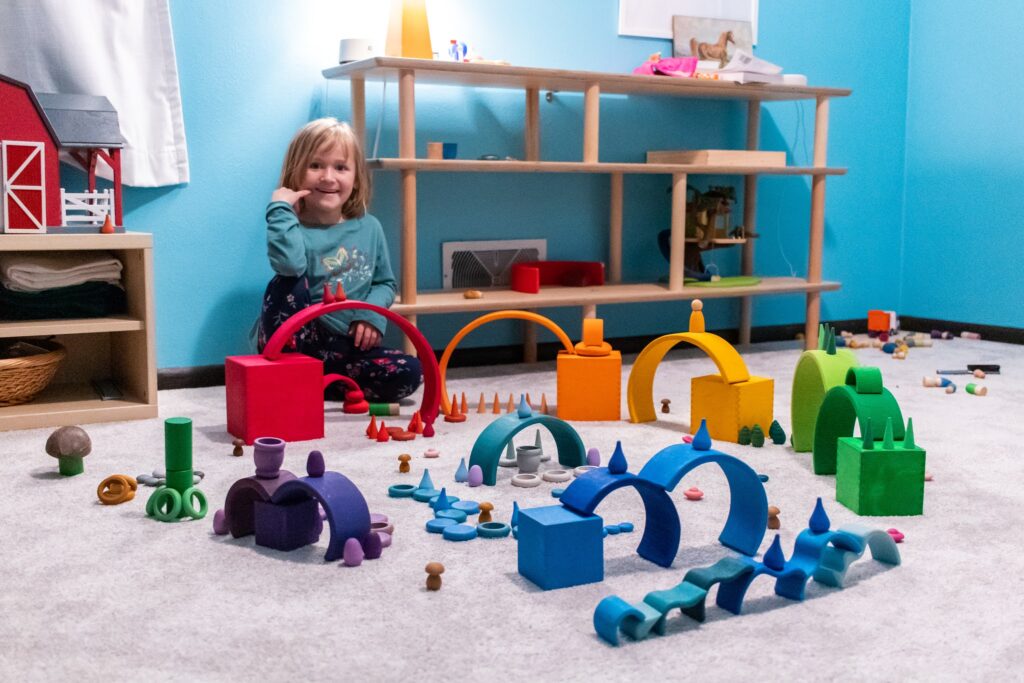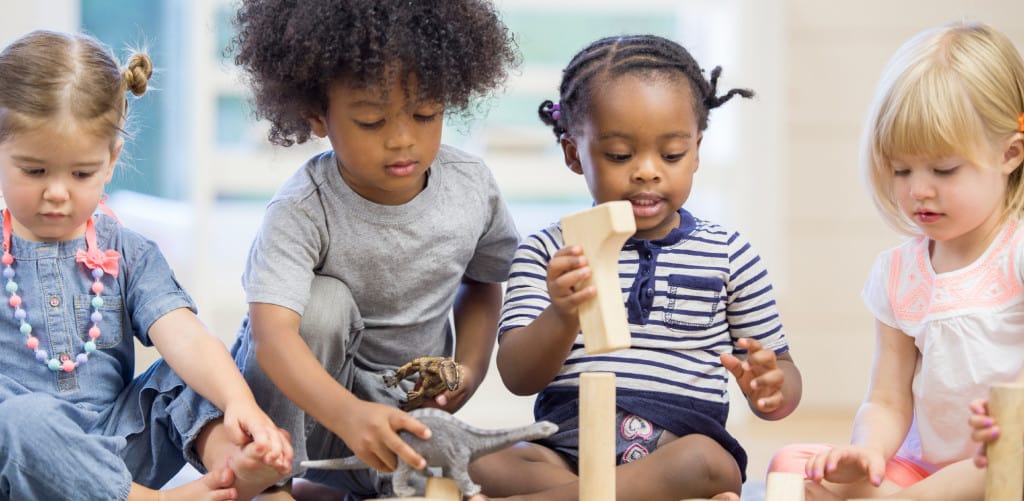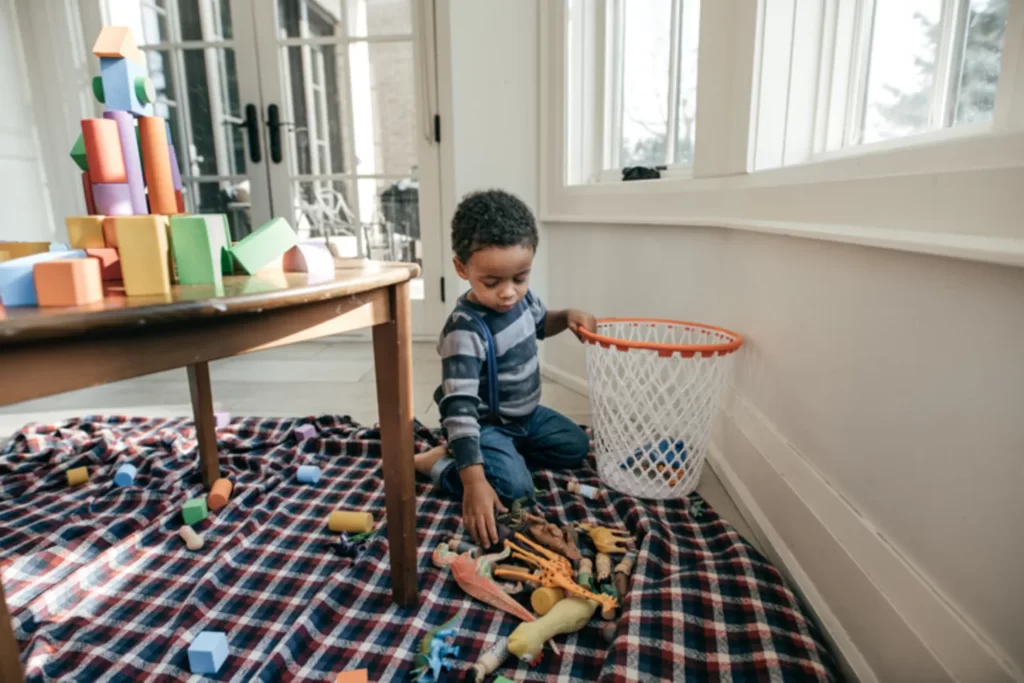If you have been considering an alternative to public education and looking for a play-based education curriculum, you have probably looked into the Montessori method of teaching. Here is your quick guide that answers what Montessori is, how it works, and examples of how play figures into the activities.
The Montessori method considers play to be a child’s work. Montessori encourages students to engage in self-directed play and utilizes a learning environment that invites collaborative play. Teachers offer activities that guide students to discover and develop their maximum potential within a supportive environment.
The Montessori classroom is designed to help child development by creating a link between the child’s natural interests and circumstances to the activities that are available around them. Montessori teaching nurtures the natural curiosities in human behavior and builds a foundation that lasts a lifetime.
Why Does Montessori Call Play “Work”?
Montessori often used the word “play” synonymously with the word “work,” as she believed that it accurately illustrated the effort children put into expanding the world around them.
Here are some important characteristics of play in Montessori:
- The activity is chosen by the child and self-guided
- The activity itself is important and valued over an end result or lesson learned.
- Guided-play is when a teacher aims a child towards a specific notion that encourages a specific idea or concept.
- Free play encourages the use of objects and socialization without oversight of an adult.
After looking through the Montessori curriculum, it is easy to see how children put their minds to work continuously to gain a new perspective and to grow and expand their world around them. Through play, they enrich their independence and master new skills.

Examples of Montessori Play and Work Activities
The principles behind the Montessori education begins with Montessori’s stage theory of development, the facility’s role, and the creation of optimal learning for the child’s development while supporting independence and self-sufficiency through each stage of life.
Each student will engage in topics through varied readings, lectures, discussions, and videos. Below are some examples of activities that students engage in that are unconventional to traditional methods of learning.
- Hands-On Alphabet: Children learn to manipulate the alphabet with their hands, instead of absorbing them on a page. Turning this into an interactive play makes learning more accessible and encourages students to be more comfortable with words.
- Interaction With The Environment Around Them: The Montessori curriculum invites students’ curiosity to explore the world around them with the motive to enhance student’s motor skills. Some of these hands-on tasks include:
- watering plants
- ironing or folding
- sweeping
- gluing paper together
- washing a table or window
- arranging flowers
- gathering supplies
- putting supplies away
These are essential activities to add as they help teach responsibility and help facilitate respect for themselves and others.
- Creative Interaction With Beads: Beadworks utilization is important for a couple of different reasons. Students can create arrangements embracing their artistic and visual side while also discovering math or geometry. For instance, one of the most common ways is to introduce children to the decimal system. When given the cube of 1000 beads, they can quickly visualize the power behind the decimal point.
- Classification Cards: These cards help to aid children in recalling and classifying objects and names of things all over the world. How it works is that each object has three cards:
- One card with a picture of an object
- A second card with the name of said object
- A third card as the “control card,” with both the picture and the title.
Here, the children match the image and the name of the object together and compare their results based on the control card. This classification can help children grasp complicated concepts. See our article on Montessori 3-part cards for more information.
- Binomial Cube: The Binomial cube is one of the first items you may notice within a Montessori class: wooden blocks specifically painted and colored coded, are different sizes, and piece together like a puzzle. It can be used to guide the child through several different activities intended to help them understand organization and begin to visualize algebraic equations.

How Montessori Differs From Traditional Classrooms
The classroom design structure itself is a triad between the student, the teacher, and the prepared classroom, whereas, within traditional learning environments, the relationship is directly between the teacher and their students. Let’s break down some of the differences between the two experiences:
- Montessori Lessons Are Hands-On: Students discover information on their own through guided activities in a prepared classroom, while traditional schools often encourage memorization and test-taking.
- Montessori Students Aren’t Rushed: Montessori classrooms encourage students to take as much time as they need and avoid interruptions when possible, while school policies and time limitations govern traditional classes.
- Montessori Teachers Are Observers: teachers at Montessori schools act more like observers and consultants to students, encouraging growth one-on-one. This is a significant difference in comparison to traditional learning methods as a teacher predetermines each lesson, and each student expects to complete tasks in the same order, at the same time, for the same curriculum.
- Montessori Curriculum is Adaptable: The curriculum adapts, as it is responsive to the individual child’s needs. Traditional classrooms predetermine their lessons and expect children to meet requirements mandated by the school either by standardized testing or to meet benchmarks governed by the school or state.
- Montessori Recognizes Behavioral Validation: The Montessori school knows that self-esteem is something that develops internally as a sense of pride for their accomplishments. This behavioral validation differs within our traditional schools as validation or external judgment contributes to self-esteem.

Play and the Montessori Classroom at Different Ages
The Montessori method continues today through the Association Montessori Internationale or AMI, where they ensure high standards for their teachers and the training of their schools. The Montessori environment supports work with children from birth to high school.
Montessori classrooms typically have a mixed-age group, as Montessori recognizes that learning is not linear and children work at their own pace. Take a look at what this would look like for each age group and what their focus may be:
- Ages 3-5: This age range explores basic behaviors like caring for themselves, those around them, and their environment. The approach is child-centered and gives children room to choose their activities.
It sparks interest to them and encourages free play where it is voluntary and of the child’s own choice to participate in the action without receiving a reward. This age range is when the classroom exercises a mix of play and practical life scenarios that aid in a learning organization, concentration, and motor skills.
- Ages 5-6: Students continue with their multi-sensory exploration as they learn the alphabet and numbers, improve on reading and writing skills while engaging with cultural studies.
This time is also when the typical studies of language, math, geography, and science come in. Their environment may include classroom pets, art, plants, and outdoor gardening to complement the classroom environment.
This is also a time where guided play is more introduced and is intended to aim a child to adopt a certain notion or way of thinking during play.
- Ages 6-9: This age range focuses on exposure to interrelated topics. It encourages students to delve deeper into the specificities, recognize the connections in more detail to deepen their understanding of the complexities of our world.
A seasoned Montessori teacher can capture children’s curiosities and have their actions contribute to their learning in constructive ways through the freedom of playtime.
- Ages 9-12: For mature students, this is an age range that embraces the continuation of play and begins the introduction of more complex topics, such as understanding our universe, biology, human life (of our purpose and how we came to be), writing, and abstract beliefs.
Our world is always evolving, and circumstances in our diverse world are ever-changing, enabling us to learn something new every day. The Montessori method of teaching enables us to embrace the beauty of discovery by encouraging self-directed exploration. No matter if we refer to it as work, or as play, these are lessons that can carry our children into their future.
